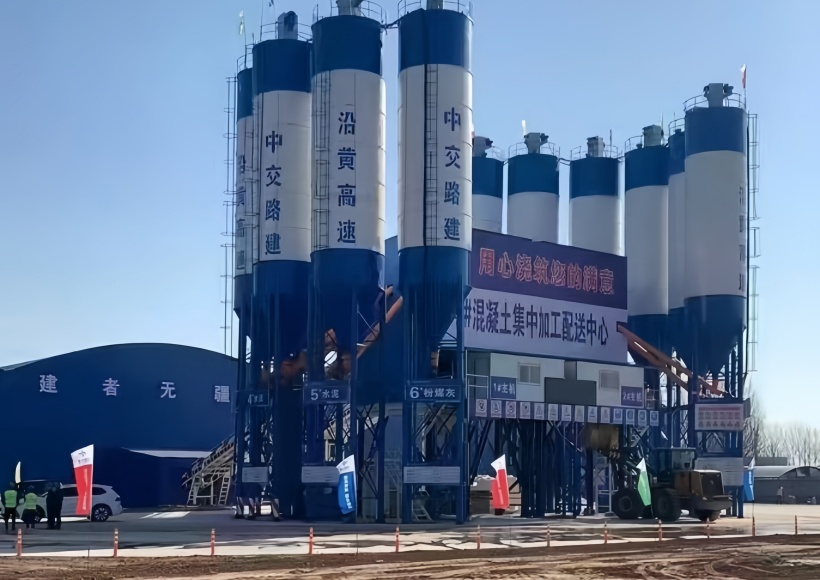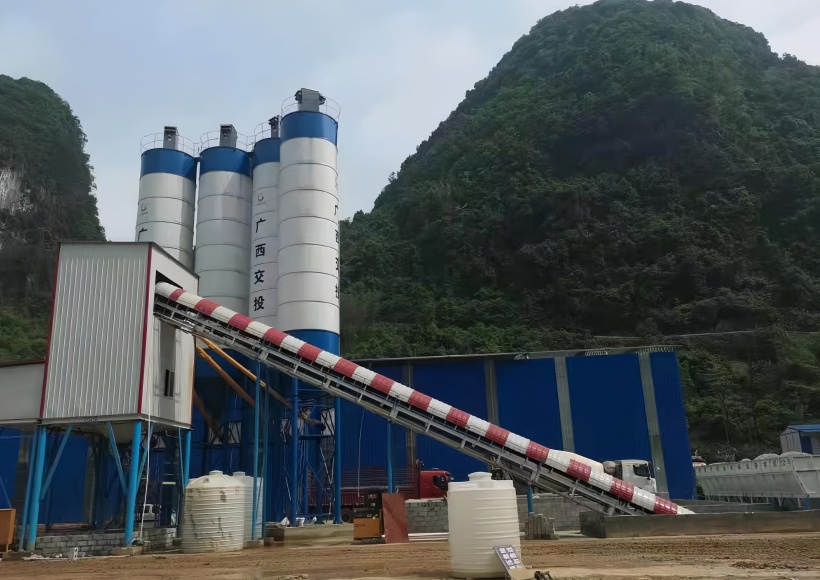The power system of a concrete mixing plant is its core power source, and a scientific and rational power configuration is key to ensuring production efficiency and economic benefits.
As the primary equipment for small-scale commercial concrete production, the HZS60 concrete mixing plant requires a sound power system configuration, which is crucial for production efficiency and operating costs. This article comprehensively analyzes the power requirements, power configuration, and transformer selection of the HZS60 concrete mixing plant, providing a professional reference for commercial concrete companies.
I. Overview of the HZS60 Concrete Mixing Plant
The HZS60 concrete mixing plant is a fully automatic complete concrete mixing system with a theoretical production capacity of 60 cubic meters per hour, capable of meeting the concrete needs of medium-sized construction projects. The plant consists of a mixing system, batching system, conveying system, and control system. Its modular design allows for quick installation and commissioning.

II. Detailed Explanation of the HZS60 Concrete Mixing Plant Power Configuration
Understanding the power configuration of a concrete mixing plant is fundamental to power system design. The following is the power distribution of each system in the HZS60 concrete mixing plant:
1. Total Installed Power
Based on the equipment configuration, the total installed power of the HZS60 concrete mixing plant is approximately 110 kilowatts (kW). This value includes the total power of all electrical equipment within the plant and is an important factor in transformer selection.
2. Power Distribution by System
- Main Mixer: JS1000 concrete mixer, equipped with a mixing motor, water pump, and admixture pump motors, with a total power of approximately 43 kW.
- Conveying System: Includes belt conveyors and screw conveyors. The screw conveyor motor has a power of approximately 11 kW, the inclined belt motor has a power of approximately 22 kW, and the flat belt motor has a power of approximately 7.5 kW.
- Air System: The air compressor motor has a power of approximately 7.5 kW.
- Auxiliary System: Includes the dust removal motor (approximately 1.5 kW) and other auxiliary equipment.
3. Actual Power Consumption Analysis
The HZS60 concrete mixing plant consumes approximately 110 kilowatt-hours (kW·H) of electricity per hour. Please note that actual power consumption will vary depending on factors such as production intensity, equipment condition, and maintenance level. Compared to other small and medium-sized concrete batching plants, the HZS60's energy consumption is moderate:
Plant Model | Power | Hourly Power Consumption (kW·h) |
HZS50 | 100kW | ≈95 |
HZS60 | 110kW | ≈100 |
HZS75 | 130kW | ≈110 |
HZS90 | 150kW | ≈130 |
Table: Power Consumption Comparison of Different Concrete Batching Plant Models
III. Transformer Selection Guide
The transformer is the core of a concrete batching plant's power system. Selecting the right transformer is crucial for ensuring stable production and reducing operating costs.
1. Transformer Capacity Calculation
The HZS60 concrete batching plant is recommended to be equipped with a 150-200 kW transformer. The transformer capacity calculation method is as follows:
According to the "Electrical Power Engineering Design Manual," transformer capacity should be selected based on the calculated load. For a single transformer providing stable power, the load factor is generally around 85%. The calculation formula is:
β = S / Se
Where:
-- β: Load factor (typically 80%-90%)
-- S: Calculated load capacity (kVA)
-- Se: Transformer capacity (kVA)
For the HZS60 concrete batching plant, the calculated load capacity is approximately 105 kW. At a power factor of 0.8, the apparent power is:
S = P / cosφ = 105 / 0.8 = 131.25 kVA
At an 85% load factor, the transformer capacity should be:
Se = S / β = 131.25 / 0.85 ≈ 154.4 kVA
In addition, a margin must be allowed to accommodate the transient voltage increase during startup. Generally, the safe voltage value should be 30%-50% higher than the total power. Therefore, a 150-200 kVA transformer is appropriate.
2. Transformer Selection Considerations
-- Voltage Level: Concrete batching plants require a 380V, 50Hz, three-phase, four-wire, or three-phase, five-wire power supply.
-- Installation Location: The distance between the transformer and the concrete batching plant should not be too far to minimize line losses.
-- Load Characteristics: Considering the high starting current of the concrete batching plant motor, increase the capacity margin appropriately.
-- Environmental Conditions: Consider the impact of local ambient temperature, altitude, and other factors on transformer operation.

IV. Cable Selection and Power Distribution System Configuration
1. Cable Cross-Section Selection
For the HZS60 concrete mixing plant with a total installed power of approximately 110 kW, 50 mm² copper cable is recommended. The following factors should be considered when selecting cable cross-section:
- Rated current carrying capacity
- Line voltage drop
- Short-circuit thermal stability
- Mechanical strength
2. Power distribution system protection devices
The concrete mixing plant's power distribution system should be equipped with appropriate protection devices, including:
- Circuit breakers: Provide short-circuit protection, overload protection, leakage protection, and isolation functions
- Contactors: Selected based on the motor's rated current and voltage
- Fuses: Provide overcurrent and short-circuit protection
- Current transformers: Used to detect current levels and work in conjunction with measurement and protection devices
V. Energy-saving measures and operational optimization
Reducing a concrete mixing plant's power consumption can significantly improve economic efficiency. The following are some effective energy-saving measures:
1. Rational production scheduling: Avoid frequent equipment starts and stops and reduce idle time.
2. Regular equipment maintenance: Keep equipment in good operating condition and reduce friction losses.
3. Optimize process parameters: Optimize mixing time and conveying speed to avoid excessive energy consumption.
4. Use Energy-Saving Equipment: Select high-efficiency motors and energy-saving transformers to reduce basic energy consumption.
VI. Precautions for Safe Electricity Use
Ensuring safe electricity use in a concrete mixing plant is a crucial aspect of production management. The following key points should be noted:
1. Grounding: All electrical equipment should have reliable grounding.
2. Lightning Protection: Lightning protection devices should be installed in substations and distribution rooms.
3. Insulation: Regularly inspect the insulation condition of cables and equipment.
4. Operating Standards: Operators must receive professional training and adhere to safe operating procedures.
5. Emergency Stop: Provide a clearly visible and easily accessible emergency stop button.
Designing the power system for an HZS60 concrete mixing plant is a comprehensive project that requires comprehensive consideration of factors such as equipment power characteristics, operating characteristics, and site conditions. Properly configuring the transformer capacity is crucial for ensuring efficient and stable operation of the plant. Selecting a 150-200 kVA transformer, equipped with appropriate cables and protective devices, can both meet production needs and achieve economical and efficient operation. It is recommended that before constructing a concrete mixing plant, Consult Tongxin Machinery's professional electrical engineers for detailed design and calculation to ensure the best power system configuration.
Through reasonable power system design and operation management, the HZS60 concrete mixing plant can provide enterprises with stable and efficient production capacity, while playing an important role in reducing operating costs and improving market competitiveness.